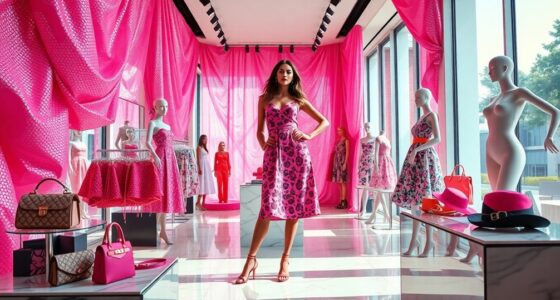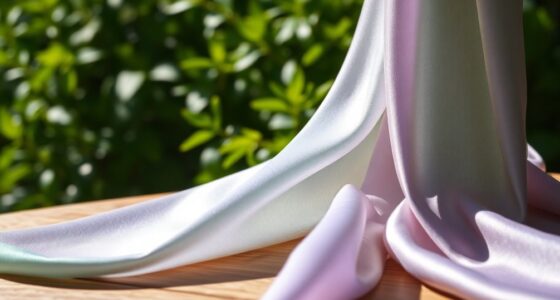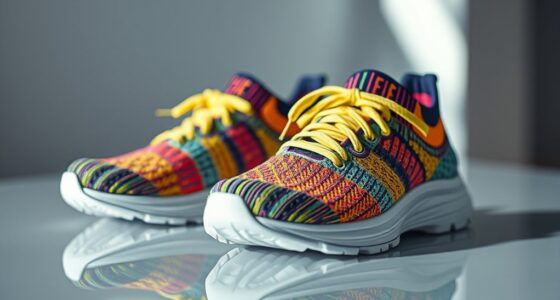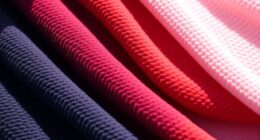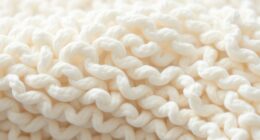Polyviscose is gaining traction as a go-to fabric for affordable fashion. It pairs the comfort and softness of viscose with the durability and wrinkle resistance of polyester, making it perfect for everyday wear. Plus, its moisture-wicking properties enhance comfort during active pursuits. However, the environmental impact of its production raises concerns. You'll want to understand both the benefits and challenges of polyviscose to see if it truly is the future of fashion. There's much more to discover!
Key Takeaways
- Polyviscose blends the softness of viscose with the durability of polyester, making it an appealing option for stylish, affordable fashion.
- The fabric's moisture-wicking properties enhance comfort, making it suitable for both daily wear and active pursuits.
- Polyviscose offers greater durability and wrinkle resistance compared to traditional viscose, ensuring garments maintain their shape over time.
- Despite its benefits, the environmental impact of polyviscose production raises concerns about sustainability and pollution.
- Innovations in polyviscose technology, such as eco-friendly practices and improved dyeing processes, are essential for addressing sustainability issues and market perception.
Understanding Polyviscose: A Blend of Nature and Synthetics
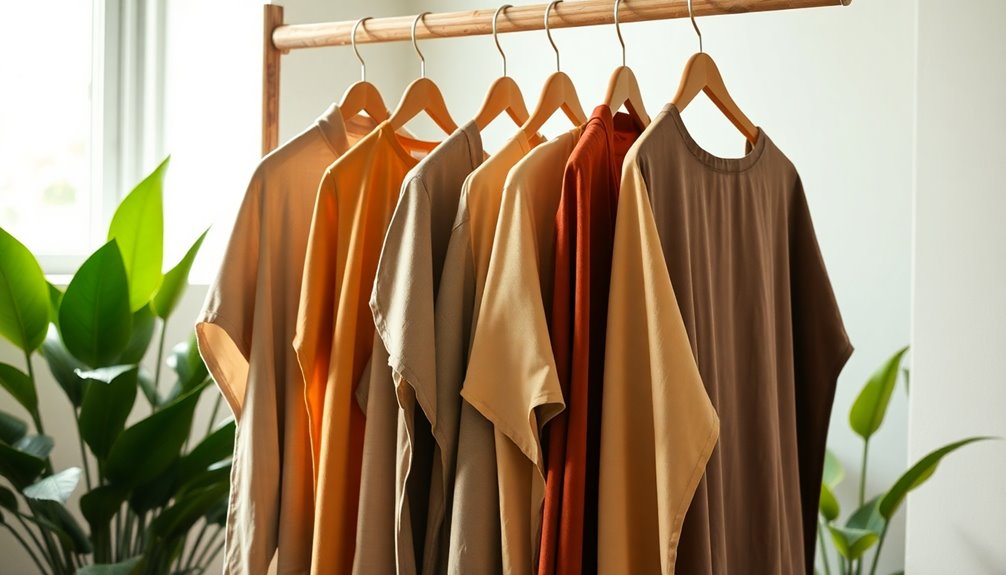
Polyviscose stands at the intersection of nature and synthetics, offering a unique blend of viscose and polyester. This fabric combines the softness and breathability of viscose with the durability and wrinkle resistance of polyester, making it ideal for a variety of fashion applications.
Its production process allows for cost-effective mass manufacturing, appealing to the fast fashion industry. As a result, polyviscose is increasingly favored for garments that require both comfort and longevity.
Furthermore, it retains moisture-wicking properties, enhancing its suitability for activewear. With a growing emphasis on sustainable fashion, polyviscose addresses consumer demand for affordable, versatile, and easy-care fabrics, signaling a promising future in the world of fashion.
The Benefits of Polyviscose in Fashion
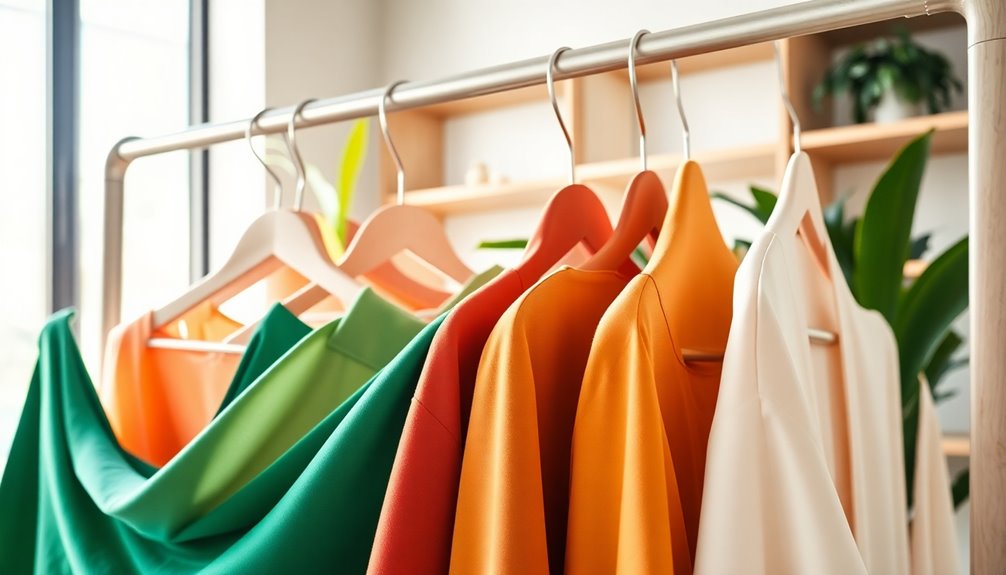
When you choose polyviscose, you're opting for a cost-effective alternative that doesn't skimp on style or comfort.
This fabric combines the softness of viscose with the durability of polyester, ensuring your clothes last longer and feel great.
Plus, its enhanced moisture-wicking properties make it perfect for both everyday wear and active pursuits.
Cost-Effective Alternative Fabric
Fashion brands are increasingly turning to polyviscose as a cost-effective alternative fabric, and it's easy to see why. This blend of polyester and viscose offers affordability without compromising quality. By reducing production costs, brands can provide stylish options that cater to your budget. Plus, polyviscose is easier to care for, appealing to your low-maintenance clothing preferences.
Here's a quick look at the benefits:
| Benefit | Description | Impact on Consumers |
|---|---|---|
| Cost-Effective | Low production costs | Affordable fashion choices |
| Durable | Wrinkle-resistant | Easy to maintain |
| Moisture-Wicking | Breathable for activewear | Comfort during wear |
| Versatile | Suitable for various clothing types | Adaptable to personal style |
| Low Shrinkage | Maintains shape after washing | Reliable garment longevity |
Enhanced Durability and Comfort
As you explore the world of polyviscose, you'll discover a fabric that not only enhances durability but also elevates comfort in your wardrobe.
This innovative blend of polyester and viscose offers enhanced durability, making your garments less prone to wear and tear. With the added strength of polyester, you won't have to worry about shrinking or wrinkling, leading to lower maintenance for your clothing.
The moisture-wicking properties of polyviscose guarantee that you stay cool and comfortable, while still enjoying the luxurious feel of viscose.
This versatile fabric option retains the desirable drape and texture of traditional viscose, making it a perfect choice for affordable fashion.
Embrace polyviscose for stylish, long-lasting comfort that fits your lifestyle.
Environmental Impact of Polyviscose Production

Although polyviscose blends offer cost-saving benefits for brands, their production carries significant environmental consequences.
The production process for polyviscose typically lacks the stringent standards that guarantee sustainability, leading to increased pollution and resource depletion.
You'll find that the use of polyester in these blends contributes to microplastic pollution, adversely affecting waterways and marine life.
Additionally, around 200 million trees are cut down annually for viscose, and the petroleum-based polyester only heightens this environmental impact.
Toxic solvents used in manufacturing pose health risks to workers and can lead to substantial pollution.
As consumer demand for sustainable and eco-friendly alternatives grows, the environmental footprint of polyviscose raises serious concerns that can't be ignored.
Comparing Polyviscose to Traditional Viscose
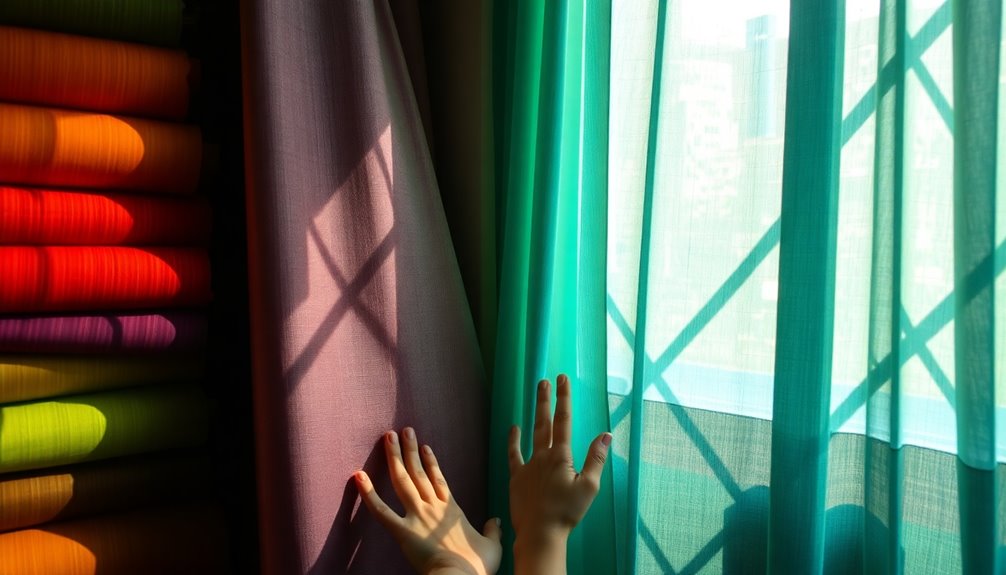
When you compare polyviscose to traditional viscose, you'll notice key differences in their composition and properties.
While traditional viscose offers softness and drape, polyviscose enhances durability and wrinkle resistance thanks to its synthetic fibers.
However, it's also important to take into account the environmental impact of these materials, especially regarding biodegradability and microplastic concerns.
Composition and Properties
Polyviscose blends the natural softness of viscose with the strength and durability of polyester, creating a fabric that's both comfortable and practical.
The typical composition of polyviscose is often a 50/50 blend of polyester and viscose, although other ratios exist to enhance specific properties.
Compared to traditional viscose, polyviscose exhibits greater strength and longevity, especially when wet, and is less prone to wrinkling.
The durability of polyviscose makes it a favorite in affordable fashion, as it maintains its appearance and wearability over time.
Additionally, the moisture-wicking properties of polyester improve comfort in various climates, while still retaining the softness and drape associated with viscose.
This combination makes polyviscose an attractive option for a wide range of garments.
Environmental Impact Comparison
While traditional viscose has garnered criticism for its environmental impact, polyviscose emerges as a more sustainable alternative thanks to its unique composition. By combining polyester with viscose, polyviscose reduces some of the detrimental effects associated with traditional viscose production:
- Reduced reliance on virgin materials: Polyester can be made from recycled plastics, lessening the demand for new resources.
- Lower water usage: The polyviscose production process typically consumes less water than traditional viscose, which requires substantial amounts for processing.
- Mitigated deforestation: With less dependence on virgin wood pulp, polyviscose helps address issues linked to chemical pollution and habitat loss.
While polyviscose retains some biodegradable qualities, the non-biodegradable polyester component poses long-term waste challenges. Additionally, adopting environmentally friendly practices like polyviscose production can significantly reduce carbon footprints.
The Role of Polyviscose in Sustainable Fashion
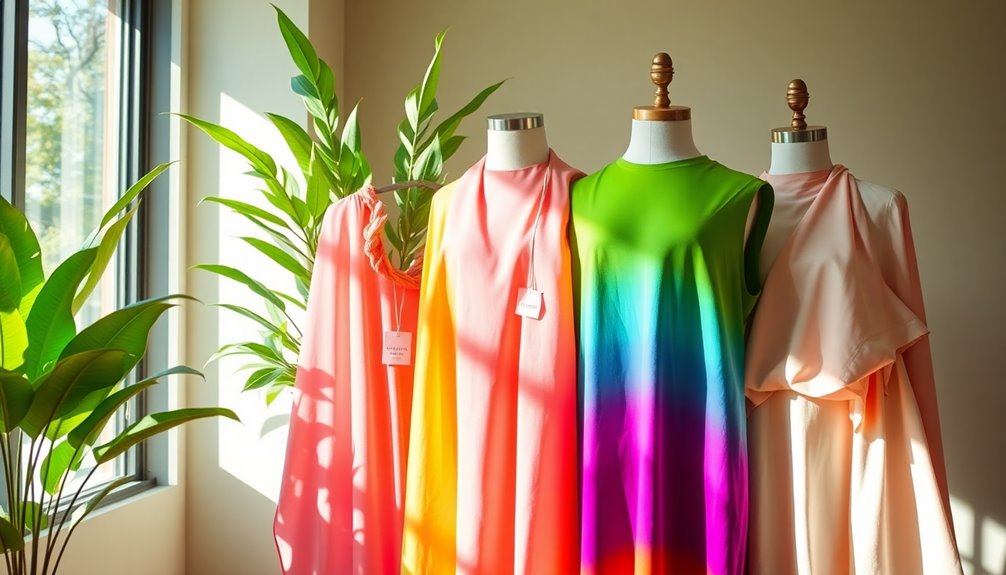
As consumer demand for sustainable fashion grows, polyviscose emerges as a compelling option that balances affordability with environmental responsibility.
This innovative blend combines the softness of viscose with the durability of recycled polyester, reducing the reliance on virgin materials and minimizing the overall environmental impact of textile production.
With polyviscose, you can enjoy comfortable, breathable fabrics without compromising on sustainability.
Innovations in sustainable production, like the use of eco-friendly dyes and reduced water consumption, further enhance its appeal.
By choosing polyviscose, you're opting for a fabric that not only offers desirable qualities but also aligns with eco-conscious values. Investment in sustainability is crucial for fostering a more responsible fashion industry.
It's a smart choice for budget-conscious consumers who want to make a positive impact on the fashion industry.
Consumer Demand for Affordable Alternatives
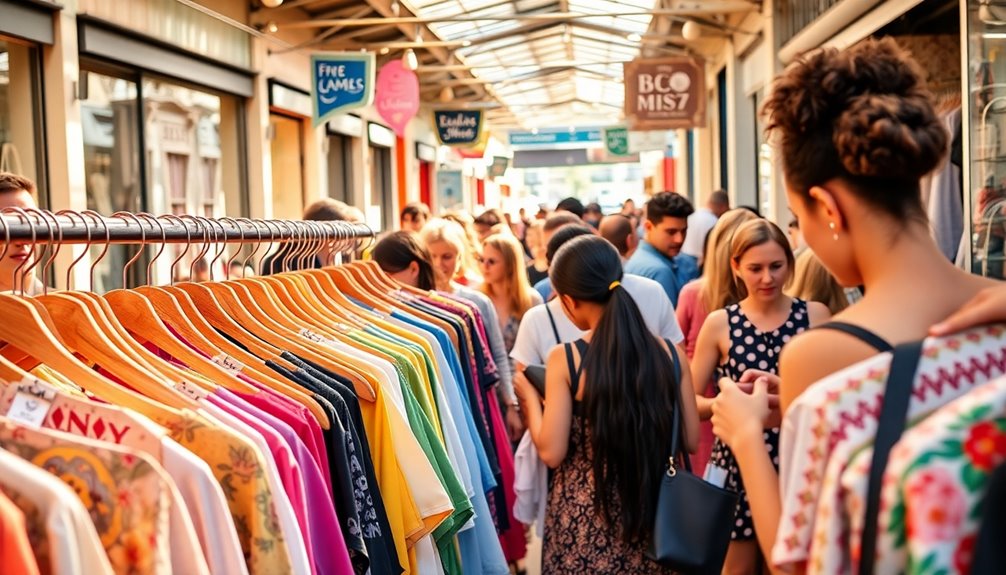
The rise of eco-conscious values has led many consumers to seek affordable alternatives in fashion without sacrificing quality or style.
With increasing consumer demand for cost-effective materials, polyviscose has emerged as a popular choice. This blend of polyester and viscose maintains desirable qualities while being budget-friendly.
Here are a few reasons why polyviscose appeals to you:
- Sustainability: It offers a more eco-friendly option compared to pure viscose.
- Affordability: You can enjoy stylish garments without breaking the bank.
- Comfort: Polyviscose fabrics are soft and breathable, meeting your comfort needs.
As changing consumer preferences continue to shape the fashion industry, polyviscose is poised to become a staple in creating chic, affordable clothing.
Innovations in Polyviscose Technology
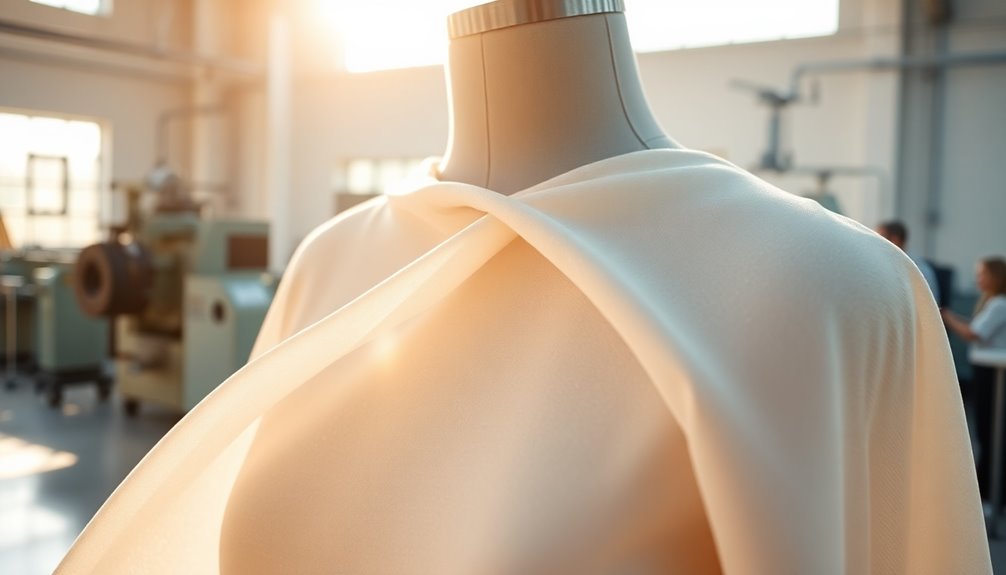
Innovations in polyviscose technology are transforming the fashion landscape, making this fabric even more appealing to consumers like you. The blend of polyester and viscose combines softness and durability, creating an ideal choice for affordable fashion.
Recent advancements have improved dyeing processes, allowing for vibrant colors while considerably reducing water and chemicals compared to traditional methods. As brands increasingly seek sustainable options, polyviscose's cost-effectiveness positions it as a frontrunner in eco-friendly textiles.
Innovations in fiber blending also enhance breathability and comfort, meeting your demands for both style and performance. With manufacturers adopting eco-friendly practices, such as using recycled polyester, polyviscose is paving the way for a more sustainable and responsible fashion future.
Challenges Facing Polyviscose Adoption
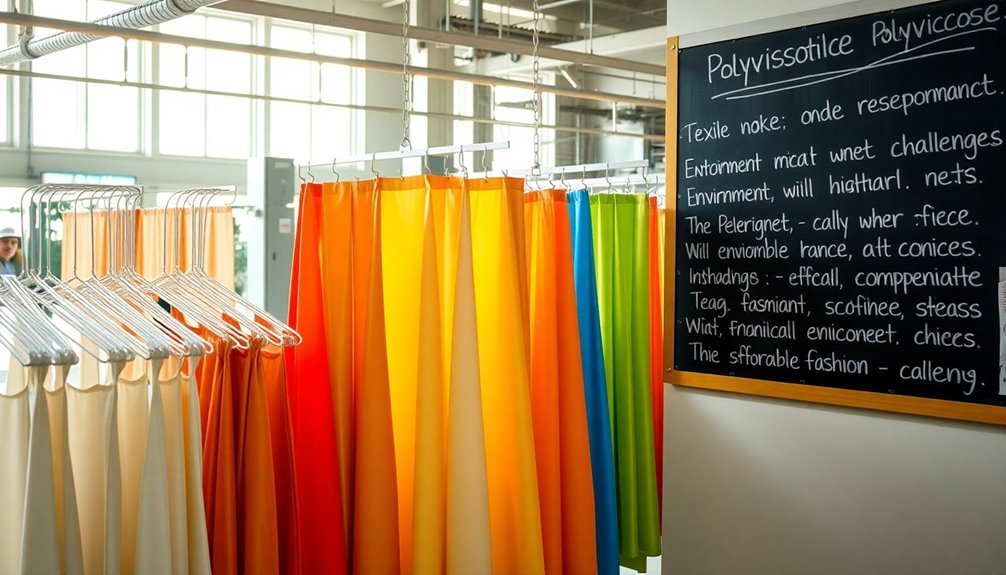
When considering polyviscose, you'll quickly notice several challenges that might impact its adoption.
Environmental concerns, quality issues, and market perception can all create hurdles for brands and consumers alike.
As you explore this fabric, it's essential to weigh these factors carefully.
Environmental Concerns and Impact
While polyviscose may seem like a fashionable choice, it poses significant environmental challenges that complicate its adoption in sustainable fashion.
The textile industry's reliance on viscose production raises serious environmental concerns, including:
- Deforestation: About 200 million trees are cut down annually for viscose, threatening forest cover and biodiversity.
- Pollution: The manufacturing processes for viscose involve harmful chemicals that can contaminate ecosystems.
- Waste: The non-biodegradable polyester in polyviscose contributes to textile waste, lingering in landfills for centuries.
These issues undermine the sustainable practices brands aim for, and the combination of polyester's carbon emissions with viscose's sourcing controversies makes polyviscose a less appealing option for eco-conscious consumers. Furthermore, the production of viscose contributes to deforestation and climate change, exacerbating the negative impact on our environment.
It's essential to take these factors into account when exploring future fashion choices.
Quality and Durability Issues
Though polyviscose offers a blend of affordability and style, it often falls short with respect to quality and durability. The synthetic polyester component can compromise breathability and comfort compared to pure viscose fabrics.
You might notice that polyviscose garments don't retain their softness and drape over time, leading to fast wear and tear. Pilling can also become an issue, creating an unattractive look and reducing garment lifespan.
Additionally, washing polyviscose at high temperatures risks shrinkage and distortion, which can hurt overall quality and affect consumer satisfaction.
While it seems like a budget-friendly choice, the long-term costs associated with these durability and quality issues could end up outweighing your initial savings.
Market Perception Challenges
How can polyviscose overcome the skepticism surrounding its environmental impact? To change market perception, brands need to tackle concerns about sustainability head-on.
Here are a few strategies:
- Emphasize transparency: Clearly communicate sourcing and production processes to build trust.
- Highlight recycling efforts: Educate consumers on how polyviscose can be recycled and its lifecycle.
- Collaborate with eco-friendly initiatives: Partner with organizations that promote sustainable practices.
The Future of Polyviscose in the Textile Industry
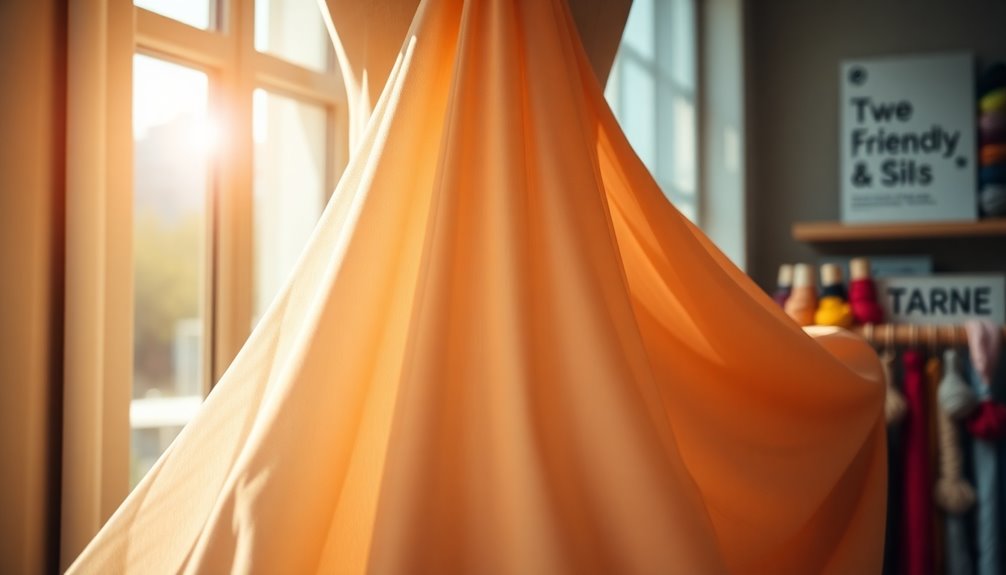
As the textile industry evolves, polyviscose is emerging as a key player due to its unique blend of affordability and performance.
This fabric's durability and comfort make it ideal for affordable fashion, meeting consumer demands for stylish yet practical clothing.
Market trends show a rising preference for blended fabrics, and polyviscose fits perfectly into this shift towards sustainable practices.
Innovations in production are reducing the environmental impact associated with traditional viscose, making polyviscose a more eco-friendly option.
As brands adopt circular economy principles, you'll find polyviscose becoming increasingly prominent in collections that prioritize responsible sourcing.
Making Informed Choices: What to Look for in Polyviscose Products

With polyviscose gaining traction in the fashion industry, knowing what to look for when purchasing these products can enhance your shopping experience.
Here are a few key factors to take into account:
- Blend Ratio: Opt for a higher percentage of sustainable viscose in the mix for better comfort and breathability.
- Certifications: Check for labels from the Forest Stewardship Council (FSC) to verify the viscose is sourced responsibly, adhering to environmental regulations.
- Care Instructions: Be mindful of care guidelines, as polyviscose can shrink or get damaged with high heat.
Frequently Asked Questions
What Are the Advantages of Polyester Viscose?
Polyester viscose offers several advantages you'll appreciate.
It combines durability with softness, making it comfortable for everyday wear while resisting wrinkles. You won't have to worry about frequent ironing!
Plus, its moisture-absorbing properties keep you feeling fresh.
You'll also find it more affordable than pure silk or viscose, making it budget-friendly.
Finally, its potential for recycling contributes to a more sustainable fashion choice, aligning with your eco-conscious values.
Is Sustainability the Future of Fashion?
Imagine a world where your wardrobe doesn't harm the planet.
Sustainability is indeed the future of fashion, and it's blossoming like a wildflower in spring. As consumers like you demand eco-friendly options, brands are shifting gears to embrace sustainable practices.
With technology shining a light on transparency, you'll soon find it easier to choose garments that align with your values.
It's not just a trend; it's a movement you can be part of.
Is Viscose Cheap or Expensive?
You'll find that viscose is generally regarded as a cheap material compared to natural fibers like silk or cotton.
Its production relies on affordable raw materials, primarily wood pulp, which keeps costs low.
However, while the initial price is appealing, you should be aware of the potential long-term costs associated with its environmental impact.
Why Do High End Brands Use Viscose?
High-end brands practically worship viscose for its luxurious drape and silk-like feel.
You'll find designers blending it with other fibers, crafting garments that scream quality while keeping costs reasonable.
Its semi-synthetic nature enables brands to create sustainable collections, drawing on biodegradable materials from renewable sources.
With viscose's impressive absorbency, you'll enjoy breathable, comfortable clothing that meets your desire for both elegance and practicality.
It's the ultimate choice for a sophisticated wardrobe!
Conclusion
As the threads of fashion weave tighter around sustainability, polyviscose stands at the forefront, blending affordability with eco-consciousness. With its versatile charm and innovative spirit, it's like a gust of refreshing air in a crowded wardrobe. By embracing polyviscose, you're not just donning a garment; you're joining a movement towards a brighter, greener future. So, as you shop, let your choices reflect your values, and watch as the fabric of fashion transforms into something truly beautiful.


